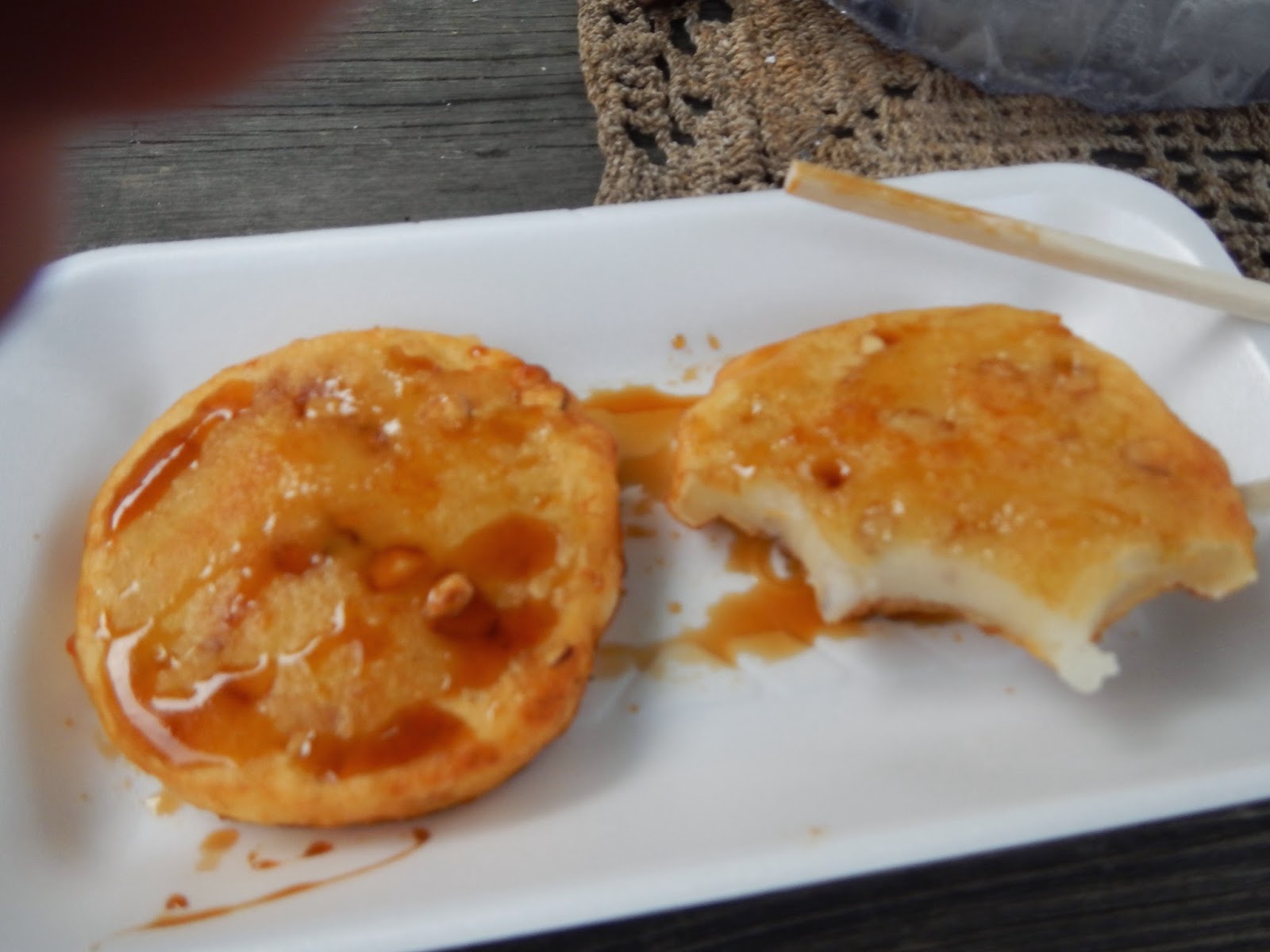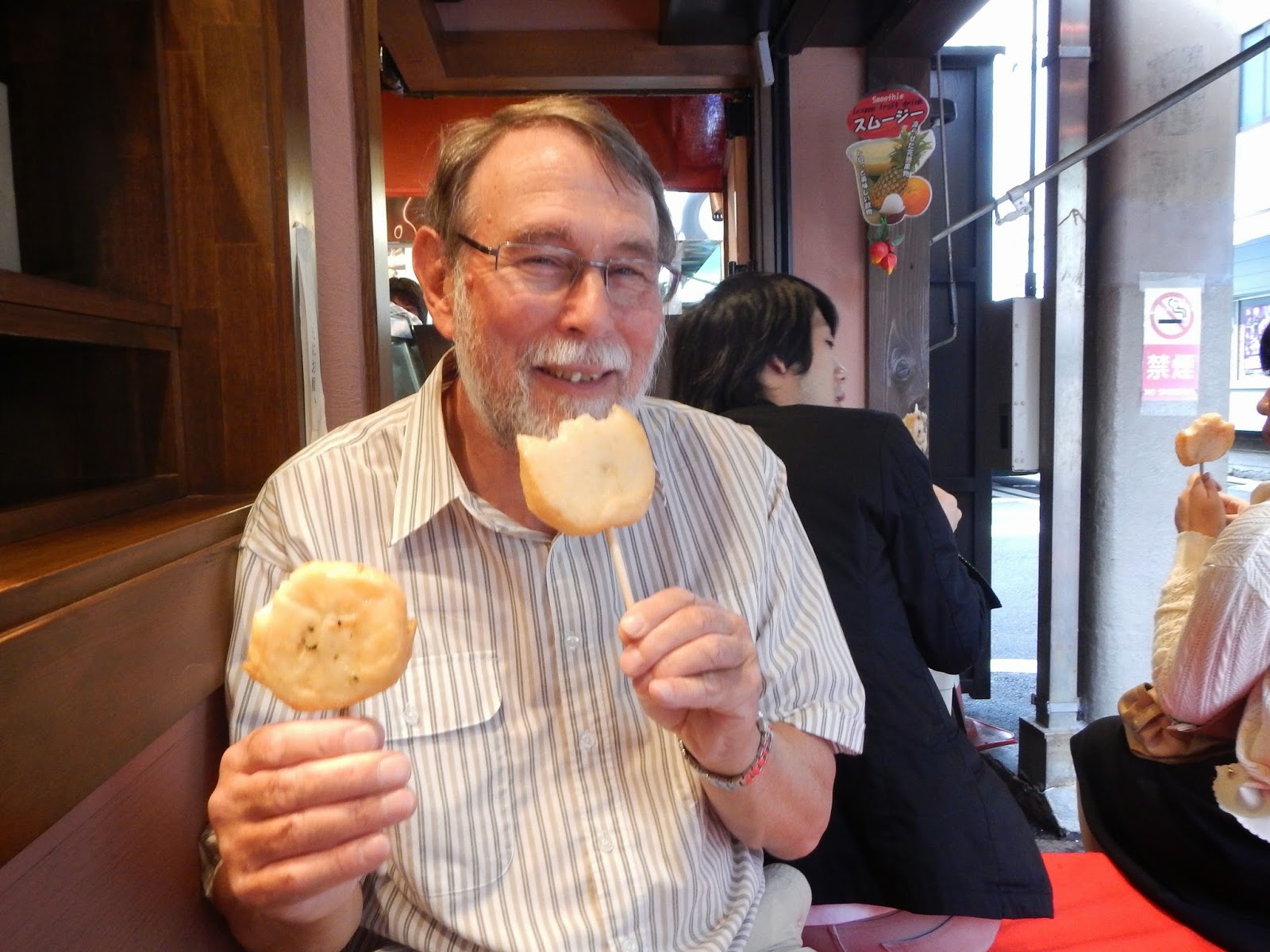Everyone asks, so we might as well get this one out of the way first: yes, what you've heard about Japanese toilets is all quite true. The heated seat (with an associated warning about low temperature burns), the musical or watery tones to disguise what you are actually up to, the discrete draught to waft away any noxious odours,
and those water sprays (surprisingly accurate!). All our hotel rooms had them, and many public facilities also, though in public places there was often a squat alternative (with polite instructions for its use). More to the point, the public toilets were almost always spotless, and the same is true for public places in general; there just wasn't any litter, and in fact litter bins were sometimes hard to find. And in a country where most things come with a lot of packaging that means that people are very responsible about their waste. And everything so thoughtfully planned: baby seats and restraints in the toilets, and every sidewalk with a ridged central strip for cane-using sight-impaired people; the ridges turn to dots at the road edge.
Our bathroom in Sapporo. Very spacious by Japanese standards (Separate shower and deep bath)
Toilet controls. You can work them out.
Changing table, Sapporo public toilet. (Note child seat hanging on the wall)
Where to put him/her while Mum gets a chance.
Tactful instructions.
Tunnel from the subway with the central strip for vision-impaired people. No prizes for guessing where it leads.
The guide books often talked about how small Japanese hotel rooms, and especially their bathrooms, were. For myself, I have no need to play football in my bedroom, so space is hardly an issue, but the rooms we stayed in were perfectly adequate and only one of our bathrooms was what you might call "compact". Our best room was sadly also our shortest stay (about 10 hours); returning to Sapporo after the birding trip we had one night in the Sapporo Grand, one of the posher hotels. The bellhop took us to the room and I thought at first that this was a new style of casually arranging the bed linen; then I realised that the room hadn't been made up at all. The poor girl was so embarrassed! We were whipped out into the lobby, and within ten minutes we had been moved to the luxury wing, into a room where a five a side football match would have been quite feasible, and the bathroom was big enough for the whole team.

Luxury shower: from above, three from middle and a flexible one for everywhere else.
Very adequate hotel room in Kyoto.
A compact bathroom, but perfectly functional.
But these were just "western" rooms and we will remember fondly the ryokan room with its tatami mats, beds on the floor, and for me, the rice husk pillows.
And the food....... To be truthful we were a little anxious on this score: the largely unknown, and with chopsticks! But fortunately we both like seafood, and I at least like it raw, and this was just as well, since it would have been hard to avoid. I signed up for the daily lunches at the conference and received a series of delights; the star was the exquisitely packed selection of nigiri and sushi, but I also liked the rice balls that came in a double cellophane wrapper to keep the outer sheet of nori crisp. There was an art to unpacking them, however! Take-san took us for a memorable lunch at a sushi place in Utoro, where we sat around the central food preparation place and either ordered items directly from the two chefs, or picked them from the conveyor belt as they came past. The fish was wonderful, and lunch for the two of us, assessed by the colour of the plates, came to ¥1700 (divide by 100, more or less).
Conference lunch box. My mouth is watering.
Sushi train, Nemuro (pinched from Google Images).
Memorable in another way were the potato pancakes that we had in the Kushiro Marsh. They were made with the seeds of one of the local water plants, giving them a nutty flavour, and served by an Ainu lady from a little roadside stall. Her husband was enjoying smoke at the bench outside and gave us a little trinket made from the seeds to the same plant. We responded by buying one of his small carvings on sale nearby.
Ainu potato pancakes, Kushiro Marsh.
In the markets, both in Sapporo and Kyoto, many of the shops and stalls cooked their own produce on the spot and had benches for customers. We had a crab lunch in the Sapporo fish market, and another sort of potato pancake on a stick in Nishiki market in Kyoto.
Crab lunch, Sapporo Fish Market. (Hairy Crab + King Crab legs)
All set. With the universal miso soup and green tea.
Potato cake on a stick. Nishiki Market, Kyoto.
Nishiki Market: green tea stall. Green tea ice cream was good.
Nishiki Market: wasabe roots. And those apples were over a dollar each.
Nishiki Market: pickled cucumbers. (It wasn't all fish).
Evening meals were always an adventure, if not a challenge. I should confess that our first (and last) meals in Sapporo were...... Italian! And very good too, but otherwise it was Japanese all the way. Our first solo one in Sapporo was a fish restaurant that was entered through a chest high wooden door that you had to duck under. Inside we were immediately greeted and seated at the bench around the central cooking area which only accommodated 10 or 12 people. We chose from the english menu, which was clearly just a small subset of what our fellow diners were getting. But it was so good that we went round twice, particularly enjoying smoked hokke, a local fish split like a kipper and grilled right in front of us.
Smoked and grilled hokke. Milder than a kipper.
We had several beautifully-presented evening meals on the birding trip, but it was always a problem to know where to begin when there was such a variety, hot and cold, solids and liquids. We asked Take about this and he was quite vague. He said he usually started with the cold items, but there was no set protocol. Each night in Kyoto we ate in one of the two food courts at the station. The restaurants there ranged from cheap and cheerful through to quite posh places, but the food was universally good. We had tempura from both ends of the scale and the only difference was that it came piece by piece, straight out of the pan, at the more expensive place, and then just in two lots at the cheaper one.
Fabulous dinner, Youroushi. Note the hot plate top left to cook mushrooms, small pieces of fish etc. Pickled fish (left centre) was my least favourite.
Prawns and crab, part of the dinner at Youroushi.
Dinner at Abishiro. Front and centre: raw sea squirt.
We had a couple of Japanese breakfasts, but when the choice was ours I'm afraid we stuck to western style in the morning.
Breakfast at Youroushi. That's a lightly poached egg at right centre. Try that with chopsticks.
Rice is pretty straightforward.
Even the take-away was good. The ubiquitous Seven/Eleven and Lawsons corner shops all had extensive take-away food, hot and cold, that we enjoyed for lunches and at least one evening meal. Sapporo was enjoying their autumn festival while we were there and Odori Park was lined with food and drink stalls in the evening. One sold delicious potato balls stuffed with pork which were so good that we went went round twice.
Takeaway from Lawsons across the road. Yakitori skewers, pork buns, rice balls, salad, beer......
So how to sum up Japan? "Fascinating" is the word I've been using, because there was so much that was so different, and yet with eyes half-closed it could have been another western society. Would I go back? Oh yes. I'm thinking of Steller's Sea-eagles on the ice flows off northern Hokkaido........
Sea otter! I forgot the sea otter! Off Cape Nosappu.


























